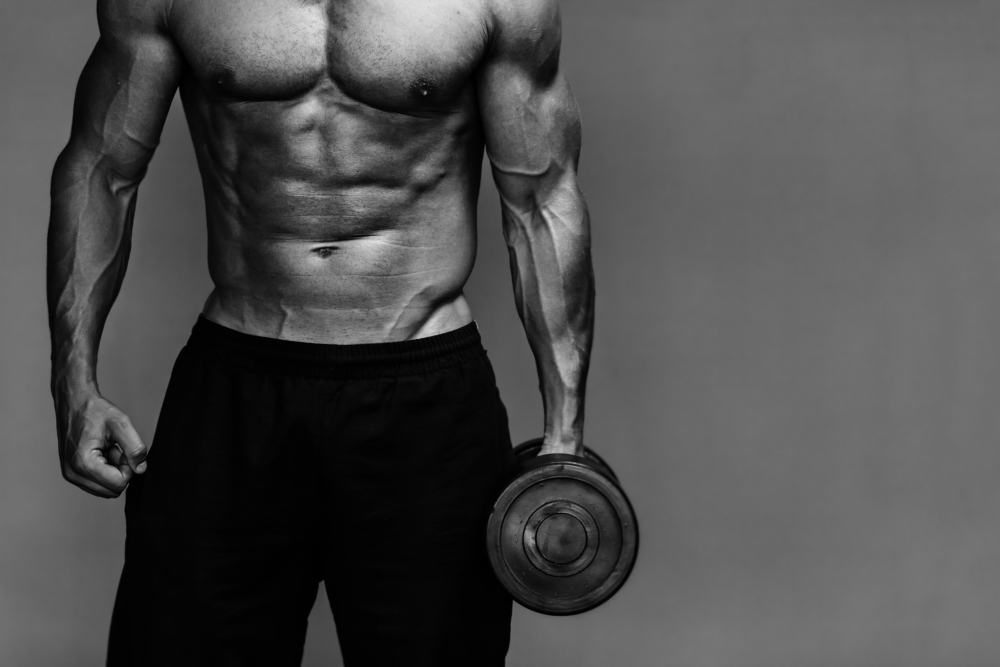Let’s be honest, most of us that give two shits about fitness on some level want to look good naked. It would be a bold faced lie to suggest otherwise. Need proof? Next time you’re at the grocery store, take a quick look at the various men’s fitness magazines on the shelves. It’s a rare cover that doesn’t feature some jacked and shredded male model with headlines promising ripped abs, big arms, and a swollen chest. Do you know why virtually every fitness magazine runs a version of this cover every single month? Because it SELLS. The editorial teams that make these cover image decisions aren’t doing it by gut instinct. They’re paying attention to the sales numbers. And the numbers don’t lie.
So what we’re saying is, we get it. The various benefits to “true strength” training that we’ve been ranting about for months just don’t have the same appeal as washboard abs or shirt stretching arms and beach ready pecs. But guess what? The sheep don’t care. The elk don’t care. The goats don’t care. Unless you’re THAT kind of farmer. But we digress.
Admittedly we’ve done a poor job of making it crystal clear that you can get MOST of the aesthetic benefits of a more traditional bodybuilding/shaping approach from your training program without actually training in that manner. And as we’ve said countless times before, the bonus is a leaner, stronger, more resilient, and more field worthy physique.
A true mountain athlete’s body that also looks good naked.
But with all this talk about “true strength”, what are the actual differences between the two styles of weight training? Before we dive into this discussion, it’s imperative we get a few terms clear. What most people consider a “bodybuilding or body-shaping” approach is scientifically known as hypertrophy training.
Merriam-Webster’s Dictionary definition of Hypertrophy:
- Excessive development of an organ or body part, specifically an increase in bulk (as by thickening of muscle fibers) without multiplication of parts.
- Exaggerated growth or complexity.
The important point to note in that definition is the reference to bulking up. More often than not, the goal with hypertrophy based strength training is an increase in the size of the muscle right down to the cellular level. Without getting too far into the weeds of cellular physiology, hypertrophy is achieved via growth in the size of the individual muscle cells. Within the muscle cells certain structures grow in size by retaining more fluid and certain proteins increase in number. Both of these effects add to muscular strength and an increase the size of the muscle being trained.
There are many reasons why one would want to put on muscle mass. For almost any contact sport this is a benefit (within reason). From the perspective of simple applied physics, the heavier you are the harder you are to move and the harder you can hit and move someone else. However when it comes to moving quickly and efficiently in rough terrain for long durations the more mass you have to carry the harder your cardiovascular system has to work. Ideally, the mountain hunter wants to increase strength, power and endurance with minimal gain in mass or bulk. Enter pure strength training.
To be honest, there is no definitive line between “true strength” training and a hypertrophy-based approach. There is no arguing that if you increase your lean muscle mass you will get stronger. So yes the two go hand in hand however it is much easier to separate the two when it comes to the training methods you would apply at the gym. But first, let’s quickly compare the definitions.
Merriam-Webster’s Definition of Strength:
- The quality or state of being physically strong.
- The ability to resist being moved or broken by a force.
- The quality that allows someone to deal with problems in a determined and effective way.
What sounds more appropriate for the mountain hunter? If you think hypertrophy you have failed today’s exam.
The main focus of true strength training is not necessarily to put on muscle mass (aka bulk). It’s to effectively load and more importantly challenge the nervous system. This approach is focused on neural adaptation or more scientifically, an increase in the neural drive stimulating the muscle contraction. Neural adaptation produces three incredibly important effects:
- Increased motor unit
- Coordination of motor unit
- Increased frequency of motor unit
We’re hoping you noted the emphasis placed on motor units. A motor unit is made up of a single motor neuron, as well as all of the muscle fibers that neuron activates. Our individual muscles are comprised of hundreds of thousands of muscle fibers. These muscle fibers are activated by motor neurons when they receive signals from the brain to contract the muscle. A single motor neuron can control several hundred muscle fibers at a time, depending on the size and function of the muscle. The body has the ability to recruit different amounts of motor units for a given task. As an example, it clearly takes far fewer motor units to lift up your toothbrush than it does and an elk quarter.
But here’s the point. Motor unit recruitment is a trained and learned ability. The more motor units you can recruit, the more muscle fibers you can activate. The more muscle fibers you can activate, the more force you can apply. Once this ability to recruit more motor units has been trained and established the coordination of multiple motor units will increase your strength even further. The more you train the more you recruit. Finally once you’ve trained the body to recruit more units and trained the coordination of more motor units (using compound, whole body movements NOT isolated body part movements) you will be able to produce an increased frequency of firing of all these motor units. All of this adds up to a stronger contraction and the ability to move more weight more efficiently.
Now some of you may be thinking that the more you train, as in the more repetitions you do of a given lift or exercise, the stronger this neural drive or adaptation will get. This is in fact true. But at what cost? For the hard charging mountain hunter, there’s a cost/benefit equation to every training decision. And as we’ve highlighted in previous articles our opinion is the TOP priority should be power to weight ratio.
THIS is where a clear line can be drawn between the two approaches. It all boils down to the frequency, intensity and duration of your training methods.
Frequency is simple, in a weight training application this equates to repetitions and sets. Repetitions are the number of times you move the weight and sets represent how many times or how long you do the given number of reps for. This shouldn’t be news to most of you.
Intensity, again in a training application, is how heavy the weight you’re lifting is and/or how hard your physiological system is working during the set or given task. For weight training specifically you will often see references to percentages of 1 REP MAX used in programming. A “one rep max” is the heaviest weight you can move for one repetition, abbreviated as 1RM. This will then be used as a percentage for your programmed lifts. For example, if your 1RM deadlift is 300lbs and your program calls for an 80% 1RM for 5 reps you would be lifting 240 lbs for 5 reps. This is a very important concept that we’ll dig into later.
Duration is how long you are training for, both from a short and long term perspective. In the short term (as in a single workout) this is how long your individual training session lasts for. In the long term, this is how long your training cycle is programmed for, usually measured in weeks or even months.
With hypertrophy training all three variables are grossly different when compared to “pure” strength training. Next month, we’ll feature Part 2 of this debate with some very concrete examples and calculations that highlight just how different these two approaches are in the gym where all this has to be put into practice.
The truth is there is no ONE way to train, BUT there are more EFFECTIVE ways to train when the desired outcome is field ready strength, durability and endurance. High repetition programs and physiologically challenging workouts absolutely have a place in the mountain hunter’s regimen. That said our stance is these methods should be employed selectively NOT exclusively. As our friends at StrongFirst like to say, be strong first then train the rest.
Still just want to look good naked? Well guess what, you can be strong, durable, and capable of covering ground for days on end AND look good at the beach this summer too. Why the hell wouldn’t you give it a shot? To be continued next month!
WANT TO TRY A “TRUE STRENGTH” BASED APPROACH. CLICK HERE.



